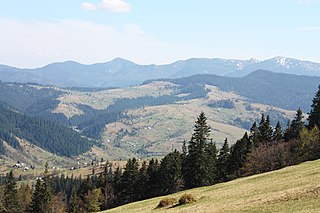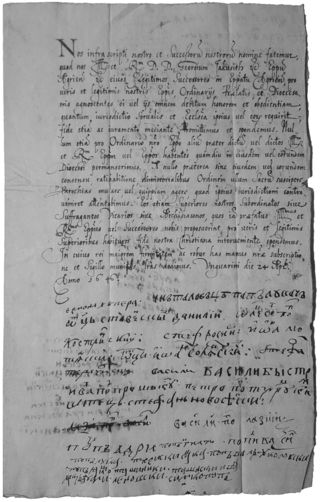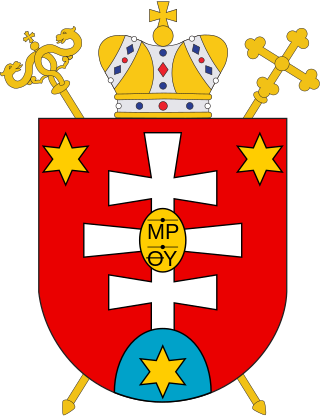Related Research Articles

Ruthenian and Ruthene are exonyms of Latin origin, formerly used in Eastern and Central Europe as common ethnonyms for East Slavs, particularly during the late medieval and early modern periods. The Latin term Rutheni was used in medieval sources to describe all Eastern Slavs of the Grand Duchy of Lithuania, as an exonym for people of the former Kievan Rus', thus including ancestors of the modern Belarusians, Rusyns and Ukrainians. The use of Ruthenian and related exonyms continued through the early modern period, developing several distinctive meanings, both in terms of their regional scopes and additional religious connotations.
The Orthodox Church of the Czech Lands and Slovakia is a self-governing body of the Eastern Orthodox Church that territorially covers the countries of the Czech Republic and Slovakia. The current primate of the Czech and Slovak Orthodox Church is Rastislav of Prešov, Metropolitan of the Czech Lands and Slovakia since 2014.
Carpathian Ruthenia is a historical region on the border between Central and Eastern Europe, mostly located in western Ukraine's Zakarpattia Oblast, with smaller parts in eastern Slovakia and the Lemko Region in Poland.

Lemkos are an ethnic group inhabiting the Lemko Region of Carpathian Rus', an ethnographic region in the Carpathian Mountains and foothills spanning Ukraine, Slovakia and Poland.

Zakarpattia Oblast, also referred to as simply Zakarpattia or Transcarpathia in English, is an oblast in western Ukraine, mostly coterminous with the historical region of Carpathian Ruthenia. Its administrative centre is the city of Uzhhorod. Other major cities within the oblast include Mukachevo, Khust, Berehove, and Chop, the last of which is home to railroad transport infrastructure.

Rusyns, also known as Carpatho-Rusyns, Ruthenians, or Rusnaks, are an East Slavic ethnic group from the Eastern Carpathians in Central Europe. They speak Rusyn, an East Slavic language variety, treated variously as either a distinct language or a dialect of the Ukrainian language. As traditional adherents of Eastern Christianity, the majority of Rusyns are Eastern Catholics, though a minority of Rusyns practice Eastern Orthodoxy. Rusyns primarily self-identify as a distinct Slavic people and they are recognized as such in Croatia, Hungary, Poland, Romania, Serbia, and Slovakia, where they have official minority status. Alternatively, some identify more closely with their country of residence, while others are a branch of the Ukrainian people.

The Ruthenian Greek Catholic Church, also known in the United States as the Byzantine Catholic Church, is a sui iuris (autonomous) Eastern Catholic church based in Eastern Europe and North America. As a particular church of the Catholic Church, it is in full communion with the Holy See. It uses the Byzantine Rite for its liturgies, laws, and cultural identity.

Znamenny Chant is a singing tradition used by some in the Russian Eastern Orthodox Church. Znamenny Chant is a unison, melismatic liturgical singing that has its own specific notation, called the stolp notation. The symbols used in the stolp notation are called kryuki or znamëna. Often the names of the signs are used to refer to the stolp notation. Znamenny melodies are part of a system, consisting of 'eight tones' ; the melodies are characterized by fluency and balance.
The American Carpatho-Russian Orthodox Diocese of North America (ACROD) is a diocese of the Ecumenical Patriarchate with 78 parishes in the United States and Canada. Though the diocese is directly responsible to the Patriarchate, it is under the spiritual supervision of the Primate of the Greek Orthodox Archdiocese of America. The diocese was led by Metropolitan Nicholas Smisko of Amissos (1936–2011). The current leader is the Metropolitan of Nyssa, Gregory Tatsis, who was consecrated on November 27, 2012.
Rusyn Americans are citizens of the United States of America, with ancestors who were Rusyns, from Carpathian Ruthenia, or neighboring areas of Central Europe. However, some Rusyn Americans, also or instead identify as Ukrainian Americans, Russian Americans, or even Slovak Americans.
Basil Takach was the first bishop of the Byzantine Catholic Metropolitan Church of Pittsburgh, the American branch of the Ruthenian Greek Catholic Church.
Stephen John Kocisko was the first Metropolitan Archbishop of the Byzantine Catholic Metropolitan Church of Pittsburgh, the American branch of the Ruthenian Greek Catholic Church

The Archeparchy of Pittsburgh is an archeparchy of the Ruthenian Greek Catholic Church that is located in the southern part of the United States of America. It is part of the Metropolis of Pittsburgh. The geographical remit of the archeparchy includes the states of Alabama, Arkansas, Kentucky, Louisiana, Mississippi, Pennsylvania, Tennessee, Texas, and West Virginia. The incumbent archeparch is the Most Reverend William C. Skurla. The episcopal seat is situated in the city of Pittsburgh.
Stephen Varzaly was a leading priest, journalist, and cultural activist for Rusyns in the United States.

The Union of Uzhhorod, was a decision by 63 Ruthenian priests of the Orthodox Eparchy of Mukachevo to join the Catholic Church made on April 24, 1646. Until rediscovery of its founding document in 2016, academics had debated the actual date of union, whether a document had been signed, and even whether the Union of Uzhhorod had even transpired at all.

The Greek Catholic Eparchy of Mukachevo is an eparchy (diocese) of the Ruthenian Greek Catholic Church that was erected by the Pope Clement XIV in 1771. The geographic remit of the eparchy includes the south-western parts of Ukraine that are roughly within Zakarpatska Oblast. As an Eastern Catholic Church, it is in full communion with the Catholic Church. The eparchy is exempt, which means that it does have a metropolitan bishop but is directly subject to the Holy See. It is supervised by the Roman Dicastery for the Eastern Churches, a Roman Curia dicastery acting on behalf of the Pope. Its parishes observe the Byzantine Rite which is also celebrated by the majority of Orthodox Christians, and as provided for in the original terms of the Union of Uzhhorod. The episcopal seat is the Cathedral of the Exaltation of the Holy Cross in the city of Uzhhorod.
Russian Liturgical Music is the musical tradition of the Russian Orthodox Church. This tradition began with the importation of the Byzantine Empire's religious music when the Kievan Rus' converted to Orthodoxy in 988.

The choral concerto, occasionally known as vocal concerto or church concerto) is a genre of sacred music which arose in the Russian Empire in the middle of the seventeenth century and remained popular into the early nineteenth century. Choral concertos are short compositions for unaccompanied voices, typically containing multiple and distinct sections, with occasional soloistic interludes. The text of the compositions was usually selected from the psalms and other biblical texts, with occasional settings from feast day sequences. Choral concertos were intended for liturgical use; they were sung at the point in the Divine Liturgy when clergy were taking Holy Communion, before the Communion of the faithful.
The Obikhod is a collection of polyphonic Russian Orthodox liturgical chants forming a major tradition of Russian liturgical music; it includes both liturgical texts and psalm settings.
The Eparchy of Mukachevo and Prešov was an Eastern Orthodox diocese (eparchy) of the Serbian Orthodox Church, that existed from 1931 to 1945. It had jurisdiction over regions of Slovakia and Subcarpathian Rusynia, at that time parts of former Czechoslovakia. Its seat was in Mukachevo.
References
- 1 2 David Drillock. "LITURGICAL SONG IN THE WORSHIP OF THE CHURCH" Archived 2011-02-21 at the Wayback Machine in ISSN 0036-3227 VOLUME 41 NUMBERS 2-3, 1997 ST. VLADIMIR’S THEOLOGICAL QUARTERLY pages 204-205]
- 1 2 3 4 5 6 Article about Prostopinije Archived 2011-08-12 at the Wayback Machine at patronagechurch.com. Published in the Byzantine Leaflet Seriess No. 23, November 1981, Byzantine Seminary Press, Pittsburgh, PA 15214
- 1 2 Prostopinije at the page of Metropolitan Cantor Institute (www.metropolitancantorinstitute.org)
- 1 2 The Cerkovnoje Prostopinije (Church Plainchant) of Father John Bokšai and Cantor Joseph Malinič
- ↑ Discussion on Prostopinije, Byzantine Forum at byzcath.org
- ↑ History of Prostopinije at puluka.com
- 1 2 Scores to download Archived 2011-07-16 at the Wayback Machine patronagechurch.com
- ↑ Prostopinije Melodies, Metropolitan Cantor Institute